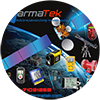Fluke 805: Vibration Meter
Features and Benefits
- Innovative sensor design helps minimize measurement variations caused by device angle or contact pressure
- Consistent data quality at both low and high frequency ranges
- Four-level scale indicates severity of problems for overall vibration and bearing condition
- Exportable data via USB
- Trending in Microsoft® Excel using built-in templates
- Overall vibration measurement (10 Hz to 1,000 Hz) for acceleration, velocity and displacement units of measurement for a wide variety of machines
- Crest Factor+ provides reliable bearing assessment using direct sensor tip measurements between 4,000 Hz and 20,000 Hz
- Colored lighting system (green, red) and on-screen comments indicate how much pressure needs to be applied to take measurements
- Temperature measurement with Infrared Temperature Sensor increases diagnostic capabilities
- On-board memory holds up to 3,500 measurements
- Audio output for listening to bearing tones directly
- External accelerometer support for hard to reach locations
- Flashlight for viewing measurement locations in dark areas
- Large screen with high resolution for easy navigation and viewing
|
|
| What is Crest Factor+? | |
| |
Crest
Factor+ is a new proprietary algorithm (or technology) that takes the
confusion out of bearing assessment. The original Crest Factor is used
by vibration analysts to identify bearing faults. It is defined as the
ratio of the peak value/RMS value of a time domain vibration signal. A key limitation of the original Crest Factor algorithm is that it does not increase linearly as the bearing degrades, making it very difficult to determine the severity of mechanical issues. In fact, the Crest Factor can actually decrease as a bearing nears catastrophic failure due to large RMS values. In order to overcome this limitation, Fluke uses a proprietary algorithm known as Crest Factor+ (CF+). CF+ values range from 1 to 16. As the bearing condition worsens, the CF+ value increases, ensuring the user is easily able to recognize the severity of the problem. To make things even simpler, Fluke has also included a four-level severity scale that identifies the bearing health as Good, Satisfactory, Unsatisfactory or Unacceptable. |
| Exporting and trending with the 805 | |
| |
Trending,
or repeated vibration measurements kept in a spreadsheet over time, is
the best method to track machine health. With 805 you can easily:
|
Specifications
Vibration Meter |
|
| Low frequency range (overall measurement) | 10 Hz to 1,000 Hz |
| High frequency range (CF+ measurement) | 4,000 Hz to 20,000 Hz |
| Severity levels | Good, Satisfactory, Unsatisfactory, Unacceptable |
| Vibration limit | 50 g peak (100 g peak-peak) |
| A/D converter | 16-bit |
| Signal to noise ratio | 80 dB |
| Sampling rate Low frequency High frequency |
20,000 Hz 80,000 Hz |
| Real time clock backup | Coin battery |
Sensor |
|
| Sensitivity | 100 mV g ± 10% |
| Measurement range | 0.01 g to 50 g |
| Low frequency range (overall measurement) | 10 Hz to 1,000 Hz |
| High frequency range | 4,000 Hz to 20,000 Hz |
| Resolution | 0.01 g |
| Accuracy | At 100 Hz ± 5% of measured value |
Amplitude Units |
|
| Acceleration | g, m/sec² |
| Velocity | in/sec, mm/sec |
| Displacement | mils, mm |
Infrared Thermometer (Temperature Measurement) |
|
| Range | -20 °C to 200 °C (-4 °F to 392 °F) |
| Accuracy | ±2 °C (4 °F) |
| Focal length | Fixed, at ~3.8 cm (1.5") |
External SensorNote: Fluke supports but does not provide external sensors |
|
| Frequency range | 10 Hz to 1,000 Hz |
| Bias voltage (to supply power) | 20 V dc to 22 V dc |
| Bias current (to supply power) | Maximum 5 mA |
Firmware |
|
| External interfaces | USB 2.0 (full speed) communication |
| Data capacity | Database on internal flash memory |
| Upgrade | Through USB |
| Memory | Up to 3,500 measurements |
Radiated Emission |
|
| Electrostatic discharge: burst | Standard EN 61000-4-2 |
| Electromagnetic interference | Standard EN 61000-4-3 |
| RE | Standard CISPR 11, Class A |
Environmental |
|
| Operating temperature | -20 °C to 50 °C (-4 °F to 122 °F) |
| Storage temperature | -30 °C to 80 °C (-22 °F to 176 °F) |
| Operating humidity | 10% to 95% RH (non-condensing) |
| Operating/storage altitude | Sea level to 3,048 meters (10,000 feet) |
| IP rating | IP54 |
| Vibration limit | 500g peak |
| Drop test | 1 meter |
General Specifications |
|
| Battery type | AA (2)Lithium Iron Disulfide |
| Battery life | 250 measurements |
| Size (L x W x H) | 24.1 cm x 7.1 cm x 5.8 cm (9.5 in x 2.8 in x 2.3 in) |
| Weight | 0.40 kg (0.89 lb) |
| Connectors | USB mini-B 7-pin, stereo audio output jack (3.5 mm Audio Plug), external sensor jack (SMB connector) |






















0 komentar:
Posting Komentar